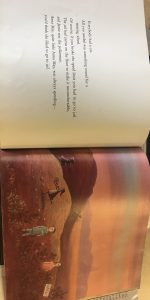Title: Roxaboxen
Author(s): Alice McLerran
Illustrator/Photographer: Barbara Cooney
Publisher and Year: Lothrop, Lee, & Shepard Books, 1991
Number of Pages: 27
Tags: Adventure, Emotion, Family, Fiction, Friendship, Picture Book, K-5, Sarah Luce
Genre: Fiction
Descriptive Annotation:
Roxaboxen is a story based on the childhood experiences of the author’s mother growing up in Arizona. It is about young kids who would play in the desert across the street from their homes as they created a town and their own little society. They made houses, streets, and businesses, had cars and horses, and even had a mayor and policeman. As the children grew into adults, they still carried their memories of Roxaboxen with them, and it was still there years later, physically and in spirit. There is an author’s note at the end, commenting on the origins of the story and how her mother’s memories helped the author and illustrator create the book.
Classroom Application:
This book could be used in classrooms to reinforce lessons about desert areas, such as Arizona, where this story originated. The illustrations depict the landscape and flora quite accurately. The book could also be used as an example to show students how to work well together in creating something. Like the children in the book played together and created a town, so could students learn to work together on things like projects and tasks in the classroom.
Linguistic and Cultural Diversity Analysis:
Depending on where one lives, this book could give a class insight into what it is like to live in a desert area. It looks much different than living in the Midwest, and there are lots of different cultures in the Western United States that are not as common in places like Illinois. It could also be used to show the culture of times in the past. In today’s society, children have many things that keep them occupied inside, like phones and tablets and television. Back in 1991 when this book was written, children entertained themselves a lot by playing outside and using imagination. This book gives insight to children who grew up being creative and inventive with what they could find outside, like “a tin box filled with round black pebbles… [that] were the money of Roxaboxen” (page 6) or creating cars out of “something round for a steering wheel” (page 15). I might introduce this book by asking my students to imagine living before a lot of technology and I might ask them what things they could do to have fun without tablets and televisions.
Illustration:


